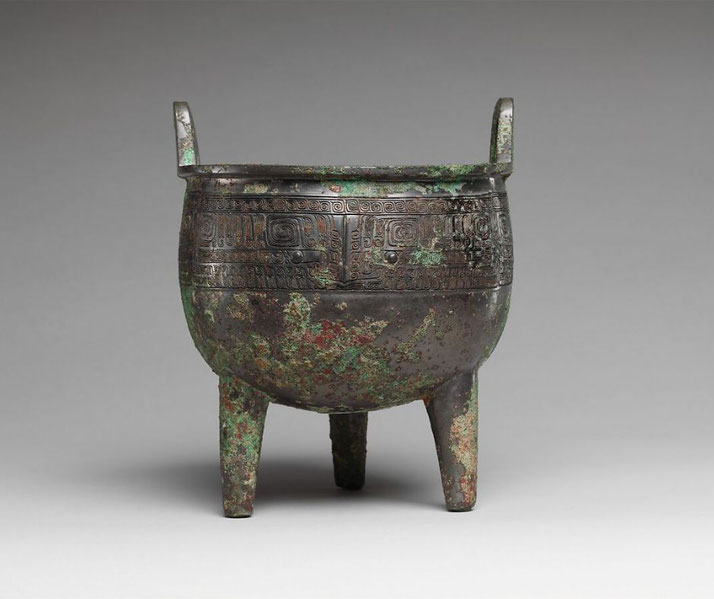The mysterious history of ancient China's Nine Tripod Cauldrons

The Nine Tripod Cauldrons, known as the Jiuding in Chinese, are one of the most mysterious and yet powerful symbols in the country’s ancient history.
They were believed to have been cast by the founder of the Xia Dynasty, and had the power to rise up, or doom, an imperial dynasty.
But, how did they work and where are they now?
The mythical origins of the cauldrons
The Jiuding appear at the dawn of Chinese imperial history in the ancient texts of Zuo Zhuan.
It says that Yu the Great, the legendary founded the first Chinese dynasty, the Xia, forged the cauldrons.
This ruler has been revered in Chinese history for his magical ability to control the Great Flood: a disastrous event that threatened to destory the entirely of early Chinese society.
After achieving this incredible deed, it is said that Yu received the mandate of heaven, which was the divine right to rule given directly from the gods.
As a result, he established the Xia Dynasty.
As part of his first act, he cast the Nine Tripod Cauldrons, which were initially meant to represent each region of Yu's territory. In a way, their existence was meant to show the unification of the different tribes under Yu's rule.

What did the cauldrons look like?
Each cauldron, according to historical records and ancient texts, had a unique in size and set of holy inscriptions.
They were made from bronze, a material that was incredibly valuable at that point in time, and involved a high level of technologically skill to cast something as large a cauldron.
Since they were tripods, they each had three legs, along with two handles.
Apparently, the handles could be moved and manipulated during particular sacred rituals.
At that time, the tripod design was growing in popularity for many objects, since the structure provided stability when placed on a flat surface.
This was an essential feature for any vessels that were placed over a fire or for boiling liquids.
In addition, the number three had significant symbolic value in ancient Chinese culture. It was associated with the heavens, the earth and the underworld.
What about the inscriptions? As far as we can tell, they were a kind of historical record that listed the achievements of the ruler and were specific to the region they represented.
They must have been written using an early form of Chinese script, similar to the Oracle Bones.
The role of the Nine Tripod Cauldrons in politics
Once created, the Nine Tripod Cauldrons became strong emblems of imperial authority: the right to rule over the people.
Those who could control them showed that they also had the mandate of heaven.
This is because they represented the overall unity of the kingdom, just as Yu had brought together different tribes and regions.
When a new emperor came to power, they had to undergo a specific set of ceremonies using the cauldrons.
If done so successfully, it was meant to prove that the gods approved of the new dynasty’s claim to the throne.
In practice, this is when the cauldrons are mentioned the most in history: either to justify a new ruler’s rise to power, or to try and calm civil unrest during times of crisis, when the people might question an emperor’s capability to lead Cina.
Their mysterious disappearance
One of the most fascinating aspects of the Nine Tripod Cauldrons is their mysterious disappearance.
The last historical record of the cauldrons comes from the late Zhou period (c. 1050–221 BCE)
Subsequently, they disappeared almost entirely from historical records.
Multiple, sometimes conflicting, accounts exist regarding their disappearance.
In the work of the historian Sima Qian, known as the Records of the Grand Historian, he wrote that the cauldrons were transported by the conquering Qin and were lost in the Si River near Pengcheng (modern Xuzhou) during the reign of King Zhaoxiang of Qin (306–250 BCE).
The Emperor Qin Shi Huang then sent a thousand men to search the river, but they found nothing.
By contrast, another theory says that Quanrong nomads captured the cauldrons when they attacked the Western Zhou capital, Haojing, in 771 BCE.
If this was the case, it was an event that would have no doubt showed that the Zhou rulers had lost the Mandate of Heaven.
In some versions, supporters of the Zhou hid or buried the cauldrons to keep them safe from looters.
They believed that losing the cauldrons would show that a dynasty had certainly lost its right to rule.
A more legendary tale says the cauldrons simply “became light and flew away”. In a spiritual sense, if the cauldrons left under their own power, this could be a way of illustrating that Heaven withdrew its support from the Zhou.
A similar version claims a dragon rose from the river and carried the cauldrons off.
Whatever really happened, the idea of the cauldrons as a demonstration of the power of ruler’s authority continued strong.
Later rulers such as Wu Zetian and Emperor Huizong made or mentioned creating new sets of nine cauldrons to prove their own right to rule.
The saying "one word is worth nine cauldrons" (一言九鼎, yī yán jiǔ dǐng) still means having complete trust and authority.
Today, researchers disagree on whether the Nine Cauldrons really existed as described, or if the story was added later.
So far, no archaeological proof has appeared. As a result of the the mix of history and myth, it makes it unlikely that we will ever know exactly what happened to them.
What do you need help with?
Download ready-to-use digital learning resources
Copyright © History Skills 2014-2025.
Contact via email
With the exception of links to external sites, some historical sources and extracts from specific publications, all content on this website is copyrighted by History Skills. This content may not be copied, republished or redistributed without written permission from the website creator. Please use the Contact page to obtain relevant permission.





